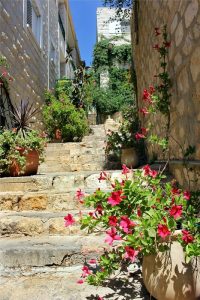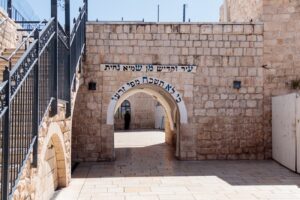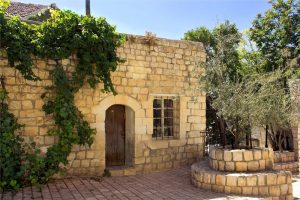Safed or Tsfat is a northern city that is a central tourist attraction in Israel. Many tourists love visiting it because of its mystical atmosphere, its cobbled stone alleyways, the art, and the historical sites of this ancient and beautiful city. The first Jewish settlements in Safed date back to the Temple period. Tsfat gained prominence as the City of Kabbalah during the centuries starting from the 16th century when rabbis and Kabbalistic scholars with other Jews fled from the Spanish Inquisition, making Tsfat their hometown on top of a mountain. The most popular tourist sites of Tsfat are the Safed Artists Quarter and Safed Citadel. You can visit Safed by yourself or through a guided tour.

The Main Landmarks Of Safed
The Safed Visitors Center
The Safed Visitors Center is situated at 17 Alkabetz Street, beneath the Ashkenazi HaAri Synagogue, and it hosts a historical exhibition with maps, guides and other tourist information. It is available a 10-minute audio-visual presentation about the history of Safed for the visitors, and there is an exhibition of archaeological remnants dating back to the 16th century and an observation deck with a fantastic view of Northern Israel.
The Safed Visitors Center is managed by Livnot U’Lehibanot, which is a unique Israel Experience Program providing program options to young Jewish adults who want to join archaeological excavations, volunteer activities, hiking and explorations.
The International Center Of Tzaft Kabbalah
The Center promotes the study of Kabbalah as it was supposed to be back to its Jewish roots, with a group of specialists offering classes and tours. The Center aims to show how Kabbalah developed in 16th-century Tzfat as a method that guides followers on how to increase their relationship with God and humans. In the Center, a 15-minute audio-visual presentation provides an overview of Kabbalah for beginners. The Center is on the second floor of the Fig Tree Gallery at Alkabetz Street.
The Ascent Institute
The Ascent Institute offers daily classes about Kabbalah, Hassidism and traditional Judaism. In the Institute, there is a low-cost hostel for travellers who want to learn about Jewish heritage. A staff rabbi manages the library of the Ascent Institute, and people can enquire about Judaism and their name meanings following the Bible codes. The Ascent Institute is positioned at 2 HaAri Street.
The Ashkenazi HaAri Synagogue
The Ashkenazi HaAri Synagogue, in the beginning, was named the Grigoris Synagogue. It was founded by a group of Jews who converted to Christianity under the coercion of the Spanish Inquisition and consequently escaped. Once they arrived in Tzfat, in the beginning, they were not instantly assimilated into the Safed community; hence they established their synagogue. The famous Kabbalistic rabbi Rabbi Isaac Luria also named the HaAri, celebrated the Kabbalat Shabbat service with his students next to this synagogue. After his death, the synagogue was renamed.
The Abuhav Synagogue
The Abuhav Synagogue was constructed in Spain, but when the Spanish government forced it to convert into a church, the 15th-century mystic Rabbi Abuhav transferred it to Tzfat. The Abuhav Synagogue has three ancient Torah scrolls that have been written by Rabbi Abuhav. Moreover, these Torah scrolls endured two earthquakes. The Abuhav Synagogue is located at Abuhav Street, beneath Yosef Caro Street.
The Kahal National Heritage Site
The site of Kahal National Heritage includes a whole 16th-century Jewish neighbourhood that has been named a National Heritage Site of Israel, which will be developed into an educational village with information and an interactive exhibition portraying the Jewish life of the Tzfat golden period and its influences on the modern Jewish world. The Livnot U’Lehibanot Israel Experience Program managed the excavations of the Kahal.
The Yosef Caro Synagogue
An ancient Jewish legend tells that Rabbi Yosef Caro sat with the maggid, which is an angel, in a room below the actual synagogue and wrote the Code of the Jewish Law, which is well-known as Shulhan Aruch. The Shulhan Aruch is a guide in Jewish life, and it is in use even today. This synagogue has the function of the Jewish Religious Court of the 15th-century that Rabbi Caro directed. One of the walls of the Yosef Caro Synagogue is used as a repository for old manuscripts that cannot be thrown away. Most of these manuscripts are hundred years old and have been written and studied by famous Kabbalists of Tzfat. The synagogue is situated on Yosef Caro Street.
The Cana’an Gallery
The Cana’an Gallery is close to the Yosef Caro Synagogue, and it has an exhibition of hand-weaving artworks.
The Tzfat Candle Factory
The Tzfat Candle Factory is close to the Ashkenazi HaAri Synagogue. It has a large assortment of candles that are suitable for Jewish rituals. In the shop, there are wax sculptures of Biblical Jewish scenes that have been made by Moshe Chaim Gress, who is the only wax sculptor in the world and a resident of Tzfat.
The Ari Sepharadi Synagogue
The Ari Sepharadi Synagogue is on Rehov HaAri, close to the Old Safed Cemetery. It was named the Elijah The Prophet Synagogue during the 16th-century when HaAri was studying Kabbalah with Elijah the Prophet in a small cavern.
The Stam Center
The Stam Center is found outside the Old Jewish Quarter, at a 10-minute drive from the Old City, on Gedud HaSlishi Street. The Center has different exhibitions and audio-video presentations of the “sofer stam” art, which consists in the creation of mezuzas, tefillin and Torah scrolls.
The City Of Tzfat
Tzfat or Safed is one of the holiest cities of Israel, and it is also the highest city in this beautiful country. It is located in the thick pine forests of the Upper Galilee, facing Tiberias and the Sea of Galilee. Tzfat is a delightful and unique mixture of ancient magnificence and contemporary refuge. For thousands of years, the antique city of Tzfat was seized many times by different civilizations. After the Great Flood, it was founded by one of the sons of Noah, and local Semitic populations inhabited this fantastic city for many years. Josephus cited Tzfat as Sepph, describing it as a fortified Jewish town in the Upper Galilee. Safed endured many years of wars between the Crusaders and the Mamlukes, and the British Mandate, remaining nowadays a charming, energetic and mystical city.

The Old City of Safed has always been a tourist attraction, starting from the immigration of Spanish Jews who escaped from Spain after the Expulsion in 1492, settling in Safed. The old buildings of Safed with an ethnic aesthetic make the visitors and citizens feel like in the past times, including modern elements. The Safed’s Old City streets and buildings have a Kabbalistic influence; indeed, as an example, the doors and windows are blue painted because of the mystical symbolism to confuse evil spirits. Besides the Kabbalah scholars, Safed is inhabited by many artists who created the Artists’ Quarter.

The Tzfat Artists’ Quarter
In the beginning, the Tzfat Artists’ Quarter was named Bohemian Center of Israel, and it is a district full of beauty and art. Several Israeli best artists have been related to this beautiful area of Tzfat. On top of the Artists’ Quarter, close to the mountain’s peak where Tzfat is located, there are buildings dating back to the British Mandate period. These constructions are pieced with bullet holes from the War of Independence that occurred in 1948. The war occurred at the peak of the mountain, where the Tzfat’s Citadel is located, and nowadays, an IDF monument stands to honour the victory.
Activities In Tzfat
In Safed, there are the Meiri Museum and the Hungarian Museum, which are both the best places for museum passionates. For religious people, Safed’s Old City is the best place to visit because of its large amount of ancient synagogues. Most of the old synagogues are beautifully constructed with old stone and wood ornamentations, with large and beautiful murals on ceilings and walls. Several ancient synagogues are still in use, and they are the best tourist attractions of Safed. Both locals and tourists are very fond of the old synagogues, and when a person visit a holy place, it is mandatory to dress modestly.

Moreover, most of the Jewish leaders are buried in the ancient Jewish cemetery located outside Safed. This cemetery is another tourist attraction for both religious and non-religious visitors, who visit it to pray or to sit among some of the most illustrious persons of Jewish history.

Outside Tzfat, there are two cities: Rosh Pina and Hazor. On the wilderness side, there is the valley of Mount Meron, which is a fantastic mountain with a breathtaking view at 1208 meters. The area is managed and protected by the KKL, the Israeli organization for foresting and upkeeping the land. The wild forests around Safed are full of old ruins and streams, and they are a beautiful place also for hiking. The Yam L’Yam Hike is the “Coast to Coast” hiking pathway that crosses through the forests outside Tzfat en route to the Sea of Galilee.

Hence Tzfat is a mystical and fantastic city to visit as soon as possible, and surrounded by breathtaking landscapes and nature.

